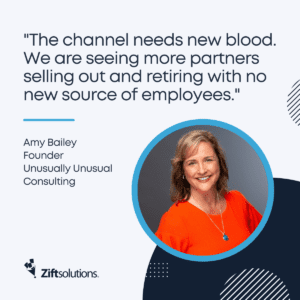- Customer events will increase in favor over vendor-partner events.
- Vendors and distributors will search for a new generation of sellers.
- Partner programs will adopt ecosystem models.
- In-person partner training will increase in 2023.
- The channel will rely on distributors even more in 2023.
- Vendor partner funds will move to long-term investment versus short-term incentives.
6 Channel Partner Program Predictions for 2023
2022 was yet another tumultuous year—for the technology industry and the channel. Economic uncertainty, the pandemic, tech layoffs and market consolidation continued.
As we transition into 2023, what lies ahead for the channel? To answer that question, we interviewed eight channel leaders about their predictions for the year ahead.
Want to skip ahead? Check out six channel partner program predictions for 2023:
- Partner Programs Will Adopt Ecosystem Models
- The Channel Will Rely on Distributors Even More in 2023
- The Channel Will Search For a New Generation of Sellers
- In-Person Partner Training Will Increase in 2023
- End Customer Events Will Increase in Favor Over Vendor Partner Events
- Vendor Partner Funds Will Move to Long-Term Investment Versus Short-Term Incentives
6 Channel Predictions for 2023 from Top Channel Partner Programs
With these partner communications and relationship management trends as our contextual backdrop, let’s dig into what the channel has in store for us in the coming year. The experts we turned to for insight have wide visibility into channel trends as advisers who serve or have served channel-focused organizations. Our panelists include:
- Amy Bailey, Founder of event planning and business consultancy Unusually Unusual Consulting.
- Kathryn Rose, Founder of channel consultancy channelWise.
- Kristine Stewart, Founder and CEO of channel consultancy The Lexington Group.
- Carolyn April, Senior Director of Industry Analysis for the nonprofit association for the IT industry and workforce CompTIA.
- Greg Plum, Director/Principal – North America for fractional partner leadership company PartnerReady.
- Theresa Caragol, Founder and CEO of partner performance consultancy AchieveUnite.
- Curt Allen, Founding Partner for channel consultancy EagleTEQ.
- Heather Tenuto, Chief Revenue Officer for partner relationship management (PRM) and channel management platform provider Zift Solutions.
Here are their predictions:
1. Partner Programs Will Adopt Ecosystem Models
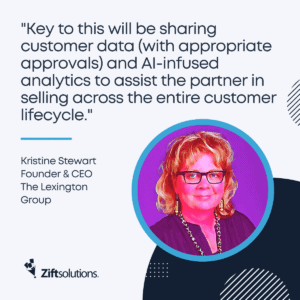 We’ve recently covered the rise of partner ecosystems in channel programs and how suppliers can build an ecosystem framework. Our expert panel pointed to further adoption of the ecosystem model continuing in 2023.
We’ve recently covered the rise of partner ecosystems in channel programs and how suppliers can build an ecosystem framework. Our expert panel pointed to further adoption of the ecosystem model continuing in 2023.
The Lexington Group’s Stewart predicts several vendors will introduce programs with more go-to-market opportunities for their partners to leverage their services portfolios and enrich their own engagements.
“Key to this will be sharing customer data (with appropriate approvals) and AI-infused analytics to assist the partner in selling across the entire customer lifecycle,” Stewart says. “Having this critical information and the appropriate marketing and enablement content at the right time can deliver huge [customer lifetime value] for both sides of the partnership.
“In conjunction with this, we are seeing new roles in the field to work with the partners to help deliver on these … roles like Partner Success Managers and Cloud Architects. The companies are also tightening up their support platforms with their service partners to deliver a more seamless experience to the client.”
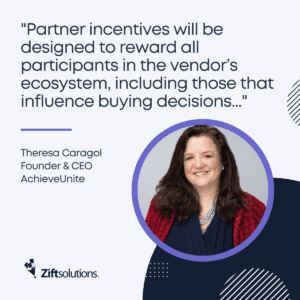 AchieveUnite’s Caragol adds that ecosystem models will naturally impact incentives and enablement initiatives. “Partner incentives will be designed to reward all participants in the vendor’s ecosystem, including those that influence buying decisions and those that impact customer success, regardless of their role in the sales transaction,” Caragol says. “More than 70 percent of vendors benchmarked by AchieveUnite are aligning incentive programs with their ecosystem strategy. Incentives, along with enablement, will also be aligned with the stages of the customer buying journey, from awareness to advocacy.”
AchieveUnite’s Caragol adds that ecosystem models will naturally impact incentives and enablement initiatives. “Partner incentives will be designed to reward all participants in the vendor’s ecosystem, including those that influence buying decisions and those that impact customer success, regardless of their role in the sales transaction,” Caragol says. “More than 70 percent of vendors benchmarked by AchieveUnite are aligning incentive programs with their ecosystem strategy. Incentives, along with enablement, will also be aligned with the stages of the customer buying journey, from awareness to advocacy.”
PartnerReady’s Plum concurs that the ecosystem approach will become more common but cautions not to mistake ecosystem and channel as the same.
“We are sure to see the channel increasingly referred to as an ‘ecosystem.’ While ecosystem is critical to understanding the modern buyer, it is not synonymous with channel,” Plum says. “Channel is but one component of a buyer’s ecosystem. Once we look at all products, services, influencers and platforms in the customer’s sphere of influence, we see that channel is an integral part of the ecosystem, but not the ecosystem in and of itself.”
2. The Channel Will Rely on Distributors Even More in 2023
As part of the emerging partner ecosystem, it’s clear to our panel that IT distribution and technology services distributors (TSDs) and brokers (TSBs) aren’t going anywhere and may even become more important.
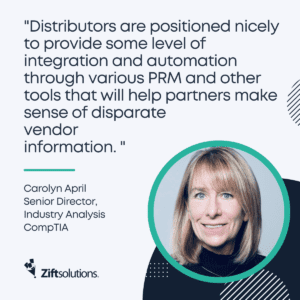
AchieveUnite’s Caragol asserts that distributors are here to stay as long as they break out of their transactional role. “The channel will rely on the distributors and technology services brokers that make the transition from transaction facilitators to solution orchestrators,” she says. “Bringing together market knowledge, technological expertise, and ecosystem relationships to orchestrate solutions built, integrated, sold and serviced by the channel ecosystem of vendors and partners.”
CompTIA’s April notes that the sheer complexity of the cloud-based solution selling environment makes distributors a vital component of the sales process for vendors and partners. “The role of distribution is oft-discussed, especially since the market has shifted away from hardware as the primary transaction to myriad cloud-based solutions and services that can be procured, delivered and managed digitally. This change has blown up the historically linear route to market of vendor-to-distributor-to-partner-to-customer.
“Today, the provider-to-customer journey for technology goods and services has many side streets and detours. This has forced distributors founded on aggregating and coordinating hardware bundles for reseller partners to reconsider their value proposition and expand what they do to help partners in a cloud environment. Partners, meanwhile, have many vendors to juggle, which means tracking products, services offerings, partner program incentives and benefits and terms, etc. It’s hard. Distributors are positioned nicely to provide some level of integration and automation through various PRM and other tools that will help partners make sense of disparate vendor information.
“Distributors are also primed to serve as an orchestrator for today’s wealth of cloud-based activities, specifically to help partners with subscription models, referral fees and other hard-to-manage and track financial aspects of SaaS and other cloud sales.”
EagleTEQ’s Allen agrees, noting the channel will continue consolidating around the TSDs. “As solutions become more and more interoperable and complex, the assistance of the TSDs on these integrated solutions plus the safety and security of their agreements makes them more valuable than ever,” he says.
PartnerReady’s Plum believes the sales engineering and support distributors offer partners is key in getting deals across the finish line. “I think TSDs offer a unique value in the channel, being strategically placed between a full suite of providers across every type of technology being consumed today and technology partners who have developed trusted relationships with their business customers,” Plum says.
 He adds that the real power is the growing suite of sales and administrative services they are now offering to their partners. “With some of the best sales engineers in the industry, TSDs are an integral part of successfully architecting a complete solution for more complex sales, making them an invaluable asset for the partner and the technology supplier,” Plum says.
He adds that the real power is the growing suite of sales and administrative services they are now offering to their partners. “With some of the best sales engineers in the industry, TSDs are an integral part of successfully architecting a complete solution for more complex sales, making them an invaluable asset for the partner and the technology supplier,” Plum says.
3. The Channel Will Search For a New Generation of Sellers
Our panel points to a growing need for the next generation of sellers as technology advisers slowly but surely begin to exit the industry through mergers, acquisitions, or retirement. While both vendors and distributors are always looking to recruit new partners, our panelists predict a more aggressive recruitment effort to bring new talent into the channel in 2023 and beyond.
EagleTEQ’s Allen explains: “I hear the TSDs and providers making a concerted effort to uncover the next generation of sellers. With all the M&A activity and sunsetting of older practices … the need for new blood is critical, and I think efforts will pick up on that front.”
Unusually Unusual Consulting’s Bailey echoes this same sentiment. “The channel needs new blood. We are seeing more partners selling out and retiring with no new source of employees,” she says, noting the channel needs to determine:
- Who is the next generation of channel employees?

- How do we train new partners?
- How do we make it easy for someone to join the channel and stay?
Bailey adds, “If a supplier or brokerage developed a program where someone would join, learn the basics, get sales training, and then be set up for success, that would be a game-changer. They would see a loyal sales base and achieve more success.”
4. In-Person Partner Training Will Increase in 2023
Partner training delivery has taken many forms since the onset of the pandemic nearly three years ago. Online self-serve, virtual and in-person trainings are now regularly available. Some panelists argue that a hybrid training approach will be common in 2023 as vendors cater to partners’ preferred training methods; other panelists say live-person training demand will increase.
“Training delivery mechanisms will continue to diversify in 2023, reflecting increasingly varied learning preferences of individual constituents and companies.,” says CompTIA’s April. “In many cases, employees from younger generations seek different paths to learning than older workers do, which drives the need to provide choice for all. Additionally, the pandemic has all-but-transformed virtual delivery and consumption of information into the new normal. Bottom line? When it comes to training, meet your partners where they are.”
Unusually Unusual Consulting’s Bailey agrees. “I think we will see a hybrid training path develop in 2023,” she says. “Self-paced video tutorials are easy for suppliers and brokerages to offer, but not everyone learns that way. Having a balance of in-person interactive training and self-paced videos will bring the most partners into the fold.”
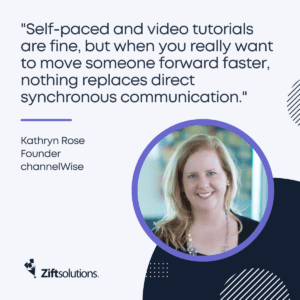 ChannelWise’s Rose notes the personal touch is preferable in engaging partners. “Self-paced and video tutorials are fine, but when you really want to move someone forward faster, nothing replaces direct synchronous communication. That is what we at channelWise do and why we do it – we want partners (and suppliers) to be supported through one-to-one conversations efficiently and affordably.”
ChannelWise’s Rose notes the personal touch is preferable in engaging partners. “Self-paced and video tutorials are fine, but when you really want to move someone forward faster, nothing replaces direct synchronous communication. That is what we at channelWise do and why we do it – we want partners (and suppliers) to be supported through one-to-one conversations efficiently and affordably.”
PartnerReady’s Plum believes the need for in-person training will grow. “I am bullish on the demand for live instruction increasing,” Plum says. “One indicator is CompTIA relaunching [its] Industry Education Instructor program. While remote training is being offered, early discussions with organizers indicate their cohorts are eager for in-person instruction.”
5. End Customer Events Will Increase in Favor Over Vendor-Partner Events
Our panel predicts that events, both virtual and in-person, will seek to engage and educate end customers as vendors and partners aim to maximize sales with more complex solutions.
“I think we will see a shift from over-the-top events for partners to educational events for end users,” said Unusually Unusual Consulting’s Bailey. “Unfortunately, I am not seeing a huge number of net-new partners joining the channel. Instead, it seems like events from suppliers and brokerages are a tug-of-war for current partners. I think we will see a decrease in live events directed at partners from the brokerages. Where we should see an increase is in the end-user-focused events. These have a better chance of bringing ROI and a faster way to fill the suppliers’ funnels.”
EagleTEQ’s Allen agrees. “I think the providers are making more concerted efforts than ever to get MDF [dollars] and activities as close to customers as possible,” he says. “Simply funding [distributor] events is not seen as anywhere near as valuable as customer-facing events with the actual sellers.”
6. Vendor Partner Funds Will Move to Long-Term Investment Versus Short-Term Incentives
Vendors incentivize partners with market development funds (MDF), competitive margins and commissions and multi-month SPIFFs to help get new sales. While our panel agrees all these incentives are here to stay, vendors will look for ways to invest in their partners’ businesses to create more-effective long-term relationships rather than just throwing money at partners to make a sale.
AchieveUnite’s Caragol explains: “Partner investment funds provided by vendors will focus more on building long-term partner success. These investment funds will assist partners in developing practices, products, services and overall business capabilities. Successful partners will generate channel growth and a rising tide floats all boats.”
Caragol shares examples of emerging investment funds, such as:
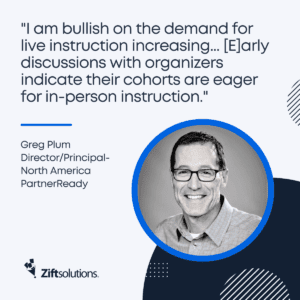
- Partner Development / Infrastructure
- Business Development
- Solution Development
- Partner Services
- Customer Life Cycle
Zift Solutions’ Tenuto, agrees. “Vendors must prioritize their investments in partners, especially in today’s economy and tightening budgets. It’s harder than ever to justify delaying revenue recognition for months by offering 10X SPIFFs just to compete for any partner with a pulse. But calculated investments in strategic business partners is a smarter option for sustainable performance, and more vendors will take it. Prioritizing those best-in-class partners is easier with a data-driven platform like ZiftONE.”
These trends listed above are key for programs to keep in mind when engaging existing partners and recruiting other vendors and companies into their ecosystem program.
Looking Back on Channel Partner Program Trends in 2022
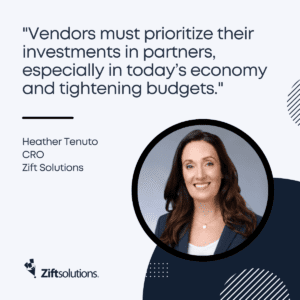 Curious about what the big trends from 2022 were? Throughout this year, we checked in with industry leaders to get a beat on everything from partner ecosystems to channel program budgets and everything in between. Two pieces, in particular, are pertinent to the year in front of us because of their focus on channel communications and relationship management.
Curious about what the big trends from 2022 were? Throughout this year, we checked in with industry leaders to get a beat on everything from partner ecosystems to channel program budgets and everything in between. Two pieces, in particular, are pertinent to the year in front of us because of their focus on channel communications and relationship management.
Channel Partner Communications Trends
In the blog 6 Best Practices for Through-Partner Communications, we discussed tips for communicating through vendors’ partners to the end customer. Key tips included:
- Learn your partners’ businesses to customize through-partner marketing.
- Seek feedback and collaboration to improve through-partner communications.
- Simplify through-partner communications with automation and customization.
- Leverage data to help partners close business with through-partner marketing.
- Integrated to- and through-partner communications are essential.
- Integration is best achieved through content planning and engineering.
Our blog 9 Best Practices for To-Partner Communications covered guidelines for how vendors can best engage directly with partners. Key guidelines included:
- Make to-partner communications about your partners.
- Tailor to-partner communications for partner types and titles.
- Get to the point in to-partner communications.
- Be purposeful about the frequency and format of to-partner communications.
- Timing is everything with to-partner communications.
- Mix it up when planning to-partner content.
- Vary delivery channels for to-partner communications.
- Measuring the success of to-partner communications is an art and a science.
- When it comes to hard metrics, the usual suspects apply.
Channel Partner Relationship Management Trends
In the blog 6 Reasons Your Channel Partner Program Needs a PRM Platform we addressed why programs should make use of PRM software platforms, which include:
- PRM software is a single source of truth and operates as the face of your company and culture to your partners.
- A PRM platform is the path to partner program scalability by providing 24/7 global access to your program resources and tools.
- PRM software protects your partner program from staff turnover by tying processes and operations to systems and roles instead of specific people.
- CRM software can’t replace a PRM platform, which is more than just a contact database and sales tracking system.
- A PRM platform provides indirect sales pipeline visibility and tracks the ROI of marketing materials and campaigns.
In the blog 6 Best Practices for Using a PRM Software Platform in Your Channel Partner Program, we tackled how best to use a PRM solution. Guidelines included:
- Get buy-in on your PRM platform from program sales and operations staff.
- Optimize your PRM platform for an ideal user experience.
- Incorporate the PRM platform in your partner program onboarding.
- Dedicate a single owner to manage the PRM platform.
- Keep partner business outcomes top of mind.
- Evangelize your PRM platform to top partners to maximize engagement.

